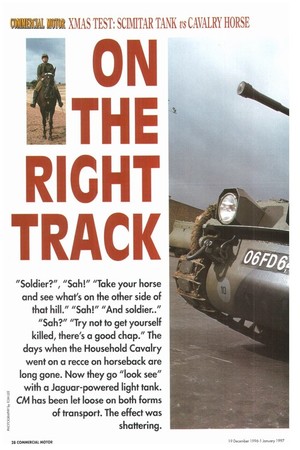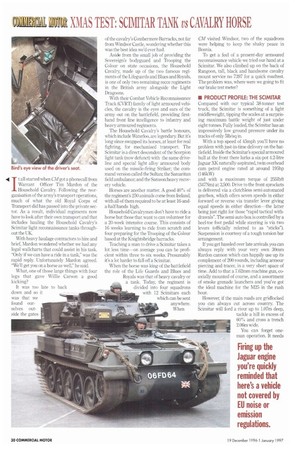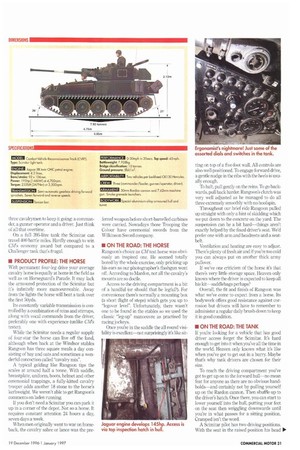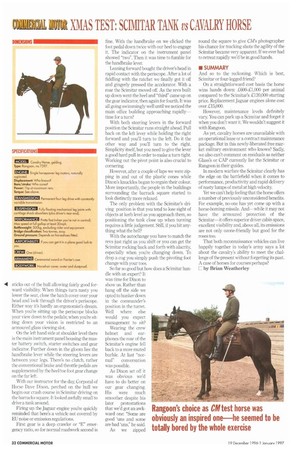N
Page 30

Page 32

Page 33

Page 34

If you've noticed an error in this article please click here to report it so we can fix it.
RIGHTTHE TRACK
"Soldier?", "Sah!" "Take your horse and see what's on the other side of that hill." "Sah!" "And soldier." "Sah?" "Try not to get yourself killed, there's a good chap." The days when the Household Cavalry went on a recce on horseback are long gone. Now they go "look see" with a Jaguar-powered light tank. CM has been let loose on both forms of transport. The effect was shattering.
41 t all started when CM got a phonecall from I Warrant Officer Tim Mardon of the Household Cavalry. Following the reorganisation of the army's transport operations, much of what the old Royal Corps of Transport did has passed into the private sector. As a result, individual regiments now have to look after their own transport and that includes hauling the Household Cavalry's Scimitar light reconnaissance tanks throughout the UK.
With heavy haulage contractors to hire and brief, Mardon wondered whether we had any legal wallcharts that could assist in his task. "Only if we can have a ride in a tank," was the rapid reply. Unfortunately Mardon agreed. "We'll get you on a horse as well," he said.
What, one of those large things with four legs that gave Willie Carson a good kicking?
It was too late to back down and so it was that we found ourselves outside the gates of the cavalry's Combermere Barracks, not far from Windsor Castle, wondering whether this was the best idea we'd ever had.
Aside from the small job of providing the Sovereign's bodyguard and Trooping the Colour on state occasions, the Household Cavalry, made up of the two famous regiments of the Lifeguards and Blues and Royals, is one of only two remaining recce regiments in the British army alongside the Light Dragoons.
With their Combat Vehicle Reconnaissance Track (CVRT) family of light armoured vehicles, the cavalry is the eyes and ears of the army out on the battlefield, providing firsthand front line intelligence to infantry and heavy armoured regiments.
The Household Cavalry's battle honours, which include Waterloo, are legendary. But it's long since swapped its horses, at least for real fighting, for mechanised transport. The Scimitar is a direct descendent of the Scorpion light tank (now defunct) with the same driveline and special light alloy armoured body used on the missile-firing Striker; the command version called the Sultan; the Samaritan field ambulance; and the Samson heavy recovery vehicle, Horses are another matter. A good 40% of the regiment's 250 animals come from Ireland, with all of them required to heat least 16-anda-half hands high.
Household Cavalrymen don't have to ride a horse but those that want to can volunteer for a 20-week intensive course. This consists of 16 weeks learning to ride from scratch and four preparing for the Trooping of the Colour based at the Knightsbridge barracks.
Teaching a man to drive a Scimitar takes a
lot less time on average you can be proficient within three to six weeks. Presumably it's a lot harder to fall off a Scimitar.
When the horse was king of the battlefield the role of the Life Guards and Blues and Royals was that of heavy cavalry or a tank. Today, the regiment is divided into four squadrons with 12 Scimitars each which can be sent anywhere. When CM visited Windsor, two of the squadrons were helping to keep the shaky peace in Bosnia.
To get a feel of a present-day armoured reconnaissance vehicle we tried our hand at a Scimitar. We also climbed up on the back of Rangoon, tall, black and handsome cavalry mount service no 7397 for a quick roadtest. The problem was, where were we going to fit our brake test meter?
• PRODUCT PROFILE: THE SCIMITAR Compared with our typical 38-tonner test truck, the Scimitar is something of a light middleweight, tipping the scales at a surprising maximum battle weight of just under eight tonnes. Fully loaded, the Scimitar has an impressively low ground pressure under its tracks of only 51b/sq in.
With a top speed of 45mph you'll have no problem with just-in-time delivery on the battlefield. Inside the Scimitar's special armoured hull at the front there lurks a six-pot 42-litre Jaguar XK naturally-aspirated, twin overhead cam petrol engine rated at around 195hp (146kW) and with a maximum torque of 2551bft (347Nm) at 3,500. Drive to the front sprockets is delivered via a clutchless semi-automated gearbox, which offers seven speeds in either forward or reverse via transfer lever giving equal speeds in either direction—the latter being just right for those "rapid tactical withdrawals". The semi-auto box is controlled by a heel-toe foot pedal while steering is via two levers (officially referred to as "sticks"). Suspension is courtesy of a tough torsion bar arrangement.
If you get hassled over late arrivals you can always reply with your very own 30mm Rardon cannon which can happily use up its complement of 200 rounds, including armour piercing and tracer, in a very short space of time. Add to that a 7.62mm machine gun, coaxially mounted of course, and a assortment of smoke grenade launchers and you've got the ideal machine for the M25 in the rush hour.
However, if the main roads are gridlocked you can always cut across country. The Scimitar will ford a river up to 1.07m deep, tackle a hill in excess of 60% and cross a trench 2.06m wide.
You can forget oneman operation. It needs three cavalrymen to keep it going: a commander, a gunner operator and a driver. Just think of all that overtime.
On a full 395-litre tank the Scimitar can travel 400 battle miles. Hardly enough to win CM's economy award but compared to a Challenger tank that's frugal.
• PRODUCT PROFILE: THE HORSE With permanent four-leg drive your average cavalry horse is equally at home in the field as well as on Horseguard's Parade. It may lack the armoured protection of the Scimitar but its infinitely more manoeuvreable. Away from the lights the horse will beat a tank over the first 50yds.
Its constantly variable transmission is controlled by a combination of reins and stirrups, along with vocal commands from the driver, preferably one with experience (unlike GM's tester), While the Scimitar needs a regular supply of four-star the horse can live off the land, although when back at the Windsor stables Rangoon has three square meals a day consisting of hay and oats and sometimes a wonderful concoction called "cavalry mix".
A typical gelding like Rangoon tips the scales at around half a tonne. With saddle, breastplate, uniform, boots, helmet and other ceremonial trappings, a fully-kitted cavalry trooper adds another 18 stone to the horse's kerhweight. We weren't able to get Rangoon's comments on laden running.
If you don't need a Scimitar you can park it up in a corner of the depot. Not so a horse, It requires constant attention 24 hours a day, seven days a week.
When men originally went to war on horseback, the cavalry sabre or lance was the pre
ferred weapon before short-barrelled carbines were carried. Nowadays those Trooping the Colour have ceremonial swords from the Wilkinson Sword company.
• ON THE ROAD: THE HORSE Rangoon's choice as CM test horse was obviously an inspired one. He seemed totally bored by the whole exercise, only pricking up his ears as our photographer's flashgun went off. According to Mat-don, not all the cavalry's mounts are so docile.
Access to the driving compartment is a bit of a handful (or should that be legful?). For convenience there's normally a mounting box (a short flight of steps) which gets you up to "Iegover level". Unfortunately, there wasn't one to be found in the stables so we used the classic "leg-up" manoeuvre as practised by racing jockeys, Once you're in the saddle the all-round visibility is excellent—not surprisingly it's like sit ting on top of a five.foot wall. All controls are also well-positioned. To engage forward drive, a gentle nudge in the ribs with the heels is usually enough.
To halt, pull gently on the reins. To go backwards, pull back harder. Rangoon's clutch was very well adjusted as he managed to do all three extremely smoothly with no hoofspin.
Throughout our brief ride Rangoon pulled up straight with only a hint of skidding which we put down to the concrete on the yard. The suspension can be a bit hard—things aren't exactly helped by the fixed driver's seat. We'd prefer one with arm and headrests and a seatbelt, Ventilation and heating are easy to adjust. There's plenty of fresh air and if you're too cold you can always put on another thick army pullover.
If we've one criticism of the horse it's that there's very little storage space, Heaven only knows where the driver is expected to keep all his kit—saddlebags perhaps?
Overall, the fit and finish of Rangoon was what we've come to expect from a horse. Its bodywork offers good resistance against corrosion but drivers will have to remember to administer a regular daily brush-down to keep it in good condition.
• ON THE ROAD: THE TANK
If you're looking for a vehicle that has good driver access forget the Scimitar. It's hard enough to get into it when you've all the time in the world. Heaven only knows what it's like when you've got to get out in a hurry. Maybe that's why tank drivers are chosen for their size.
To reach the driving compartment you've got to get up on to the forward hull—no mean fear for anyone as there are no obvious handholds—and certainly not by pulling yourself up on the Rardon cannon. Then shuffle up to the driver's hatch. Once there, you can start to lower yourself into the hull, putting your feet on the seat then wriggling downwards until you're in what passes for a sitting position. Cramped isn't the word.
A Scimitar pilot has two driving positions. With the seat in the raised position his head sticks out of the hull allowing fairly good forward visibility. When things turn nasty you lower the seat, close the hatch cover over your head and look through the driver's periscope. Either way ifs hardly an ergonomises dream. When you're sitting up the periscope blocks your view down to the pedals; when you're sitting clown your vision is restricted to an armoured glass viewing slot.
On the left hand side at shoulder level there is the main instrument panel housing the master battery switch, starter switches and gear indicator. Further down in the gloom lies the handbrake lever while the steering levers are between your legs. There's no clutch, rather the conventional brake and throttle pedals are supplemented by the heel/toe foot gear change on the far left, With our instructor for the day, Corporal of Horse Dave Dixon. perched on the hull we begin our crash course in Scimitar driving on the barracks square. It looked awfully small to drive a tank around.
Firing up the Jaguar engine you're quickly reminded that here's a vehicle not covered by ELT noise or emission regulations.
First gear is a deep crawler or "E" emergency ratio, so for normal roadwork second is fine. With the handbrake on we clicked the foot pedal down twice with our heel to engage it. The indicator on the instrument panel showed "two". Then it was time to fumble for the handbrake lever.
Leaning forward bought the driver's head in rapid contact with the periscope. After a lot of fiddling with the ratchet we finally got it off and gingerly pressed the accelerator. With a roar the Scimitar moved off. As the revs built up down went the heel and "third" came up on the gear indicator, then again for fourth. It was all going swinuningly well until we noticed the main office building approaching rapidly— time for a turn?
With both steering levers in the forward position the Scimitar runs straight ahead. Pull back on the left lever while holding the right forward and you'll turn to the left. Do it the other way and you'll turn to the right. Simplicity itself, but you need to give the lever a good hard pull in order to make a turn tight Working out the pivot point is also crucial to cornering.
However, after a couple of laps we were zipping in and out of the plastic cones while Dixon's knuckles began to regain their colour, More importantly, the people in the buildings surrounding the barrack square started to look distinctly more relaxed.
The only problem with the Scimitar's driving position is that you tend to lose sight of objects at kerb level as you approach them, so positioning the tank close up when turning requires a little judgement. Still, if you hit anything what the hell?
With the autochange you have to match the revs just right as you shift or you can get the Scimitar rocking back and forth with alacrity, specially when you're changing down. To drop a cog you simply push the pivoting foot change with your toes.
Wearing the crew helmet and earphones the roar of the Scimitar's engine fell back to a more muted burble. At last "normal" conversation was possible.
As Dixon set off it was obvious we'd have to do better on our gear changing. His were much smoother despite his later protestations that we'd got an awkward one: "Some are good 'uns and some are bad 'tins," he said.
As we zipped round the square to give Ofs photographer his chance for tracking shots the agility of the Scimitar became very apparent If we ever had to retreat rapidly we'd be in good hands.
• SUMMARY And so to the reckoning. Which is best, Scimitar or four-legged friend?
On a straightforward cost basis the horse wins hands down: L600-.£1,000 per animal compared to the Scimitar's £120,000 starting price. Replacement Jaguar engines alone cost over .C15,000.
However, maintenance levels definitely wary. You can park up a Scimitar and forget it when you don't want it. We wouldn't suggest it with Rangoon.
As yet, cavalry horses are unavailable with an operational lease or a contract maintenance package. But in this newly-liberated free market military environment who knows? Sadly, we also can't comment on residuals as neither Glass's or CAP currently list the Scimitar or Rangoon in their guides.
In modern warfare the Scimitar clearly has the edge on the battlefield when it comes to performance, productivity and rapid delivery of nasty lumps of metal at high velocity.
Yet we cant help feeling that the horse offers a number of previously unconsidered benefits. For example, no-one has yet come up with a horse-homing missile. And while it may not have the armoured protection of the Scimitar—it offers superior driver cabin space, excellent visibility and, above all, its emissions are not only ozone-friendly but good for the roses too.
That both reconnaissance vehicles can live happily together in today's army says a lot about the cavalry's ability to meet the challenge of the present without forgetting its past. A case of horses for courses perhaps?
by Brian Weatherley








































































































































